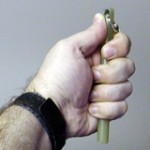
Five or six inches of wood, plastic, or metal doesn’t seem like much, does it? A dowel not much bigger than an ergonomic writing pen is actually among one of the most effective close-quarters self-defense weapons you probably aren’t carrying. Innocuous, usually legal, and very useful, the pocket stick is an accessory that everyone can afford.
Pocket sticks go by various names. Many people call them kubotans (named for Tak Kubota) or yawara sticks (which might strike some as calling a bo a “bo staff,” but let’s not get picky here). Don Cunningham, in his book Secret Weapons of Jujutsu, indicates that fist loads were sometimes referred to as tenouchi (literally, “inside the hand”). There is also the koppo, a pocket stick with a loop of cord for the index and middle fingers. (The concept is similar to that of the suntetsu, also described in Mr. Cunningham’s book — a metal pocket stick with a metal or flexible loop for the middle finger.)

The reality of the pocket stick is that it really is a weapon — a rigid length of material that concentrates and therefore amplifies the force of your strike into a smaller area. The pocket stick doesn’t feel pain and is less vulnerable to breaking than the bones of your hand. This is simple physics and biology at work. Anyone who tells you they “don’t believe in pocket sticks,” or who offers a variety of excuses for why such simple implements don’t work, can’t work, or don’t work as well as using your bare hands in self-defense, simply doesn’t know what he’s talking about. There are no shortage of those prepared to pontificate from ignorance where the pocket sticks are concerned… but their inability to recognize the utility of this tool has no bearing on the truth.
USING POCKET STICKS
Techniques used with pocket sticks can be as simple or as complex as you decide to make them. There are various resources available on the yawara, particularly, and of course there is (are?) the manual(s) written for Tak Kubota’s kubotan. To summarize, however, pocket sticks can be used in the following ways:
- As fist loads (though the weight is negligible, pocket sticks lend rigidity to the fist)
- For hammerfist strikes
- For open-hand strikes and blocks (in the case of the koppo and suntetsu)
- For thrusting attacks to vulnerable points (eyes, throat, pressure points, certain muscles)
- To facilitate joint locks and control/compliance techniques (most often as a lever)
Many people carry the pocket stick as a keychain, which makes good sense. Keychains are seen by most others (including authority figures) as just that — benign, everyday items. On a trip to a large amusement park not long after September 11, 2001, I was confronted by metal detectors at the main gate. My tiny Swiss Army Knife and Leatherman Micra were confiscated, but park security personnel let me walk away with my polymer koppo without giving it a second glance.
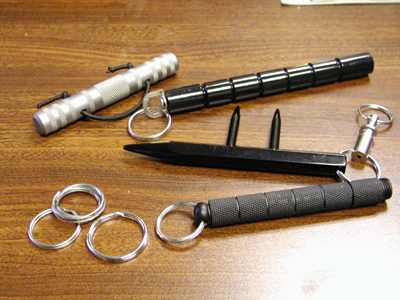
If you do carry a pocket stick as a keychain, avoid the ridiculous advice to use it as a handle with which to flail your cluster of keys at an attacker. This might irritate someone but is of very little offensive (or defensive) value. Keys are just too light to accomplish much when used in this fashion (though of course flicking them to the attacker’s eyes will have some effect).
I carry my car key on my koppo. The key is attached with a quick-detach keyring so I don’t have to leave my koppo if I need to surrender my car key to a mechanic or rental agency. (Quick-detach rings are cheap and readily available wherever car accessories are sold. Buy yourself a few to keep for each pocket stick. If possible, buy the same brand so you can detach your key from one pocket stick and attach it again to another one if you feel like switching them.)
CARRYING POCKET STICKS
One of the most common questions people ask about pocket sticks (after inquiring about how to use them for defense) is how to carry them. Everyone is different. Depending on your body type, you may find them uncomfortable to carry in your front pockets. I’ve read accounts of people who carry them upright in their back pockets next to their wallets, with or without paracord lanyards to facilitate pulling them out (some people find that keys on the pocket stick get in the way when using the stick for defensive techniques or locks or what have you). You might choose to carry the pocket stick in the front or inside pocket of a jacket. You might also simply carry it in your hand all the time, if you’re one of those people who almost never carries keys in his or her pockets when out and about.
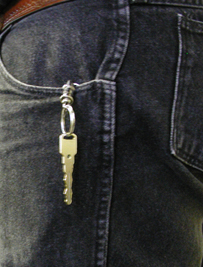 My own preference is to carry a single car key on my koppo. The key dangles freely from my pocket as it would if the keys were attached to one of those belt rings some folks wear. (Yes, it jingles about a bit, and yes, if you’re afraid of muggers running past to snag lanyards or other items hanging from your pockets, you will not be comfortable with this method.) The key keeps the pocket stick more or less in the same position all the time and provides me with an easy means of drawing it.
My own preference is to carry a single car key on my koppo. The key dangles freely from my pocket as it would if the keys were attached to one of those belt rings some folks wear. (Yes, it jingles about a bit, and yes, if you’re afraid of muggers running past to snag lanyards or other items hanging from your pockets, you will not be comfortable with this method.) The key keeps the pocket stick more or less in the same position all the time and provides me with an easy means of drawing it.
When I draw the koppo (with my left hand — I have become accustomed to performing pocket stick techniques with the left hand because that is where I carry my keys in order to leave my right front pocket free for a tactical folding knife), the key helps me index the pocket stick automatically. As the pocket stick is drawn up, it is in the perfect position for hammerfist strikes while the key is in my hand and ready for a quick entry to the automobile.
As with everything, how you choose to carry and deploy your pocket stick is a function of what works best for you. You still have many options before you, however. You must choose from wooden, metal, and plastic pocket sticks from a variety of manufacturers and sources.
SELECTING POCKET STICKS
The standard kubotan is fairly widely available and a pretty good choice. I’ve seen them of plastic and metal. The same basic shape can also be had in wood. What you prefer will depend largely on the relative weights of the sticks.
One substitute for pocket sticks that is even more innocuous in appearance than these keychains is small flashlights. The standard AA maglight is the perfect size for use as a pocket stick (though striking with real force is almost certain to damage it in some way). You can wrap these with paracord as discussed on this site. There are other methods of applying finger rings to these tools, too.
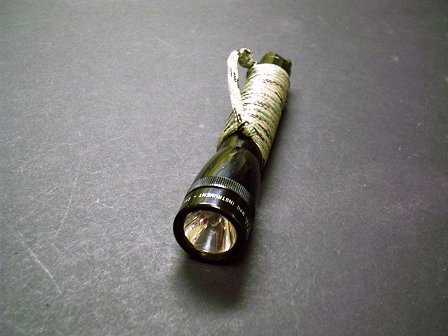
“Koppo-ized” flashlight — an AA Maglight wrapped in paracord.
There are quite a few tapered metal pocket sticks on the market. The taper makes blows with the tip of the pocket stick more powerful by concentrating the force in a smaller area. This may or may not be a good thing. Some may find these types of sticks are actually less comfortable in the pocket. Others will worry that a tapered stick is more likely to be seen as a weapon should the owner be stopped and searched by a police officer or security guard.
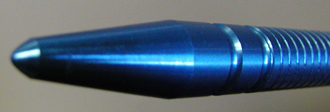
Tapered pocket stick in anodized aluminum.
Pocket stick lengths vary a bit, with the tapered aluminum sticks often a bit shorter than the nontapered wooden, plastic, or metal sticks. This may make a difference to you depending on how you choose to carry your pocket stick. I know that the length of my polymer koppo is perfect for the size of my pockets, while a shorter or heavier stick might slip inside rather than sitting where I prefer to keep it.
Be advised, when selecting a pocket stick, that if you carry it as a keychain and use it with your car keys, it might be possible for the weight of the stick and keys to cause some kind of problem with your ignition. I’ve never had this problem myself and find it hard to believe, but I’ve been told by others that the possibility exists. Personally, I think you’d have to have a brick attached to your car key before it would be an issue.
If you prefer your pocket stick smaller rather than longer, which puts it in the “fist load” category as it shrinks to fit completely in your palm, you may prefer the no-longer-available (as far as I know) Shomer-Tec Ti-Bop, if you can find one. This titanium fist load is very comfortable (the knurling is just right, in my opinion), light, strong, and has an elastic finger loop that eliminates the need for tedious sizing and resizing of the loop. The Ti-Bop cannot be used as a keychain, however, so be aware that you’re now carrying something that a police officer might consider “reverse brass knuckles.”
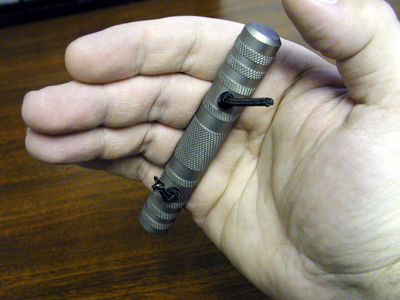
Shomer-Tec Ti-Bop.
ITEMS TO AVOID
There are a few pocket-stick-style implements on the market, relatively common in martial arts catalogs and stores, that I do not recommend. Any of the metal pocket sticks incorporating concealed blades are poor choices. Such a device will get you in a great deal of trouble if its true nature is discovered by a curious law enforcement officer. As the blade takes a great deal of time to remove and reattach to the body of the “stick,” it cannot be employed when you need it anyway — rendering the whole device an exercise in folly. The risks outweigh the dubious benefits. The same is true for the pocket sticks that look like metal kubotans and are hollow inside for carrying metal “throwing spikes.”
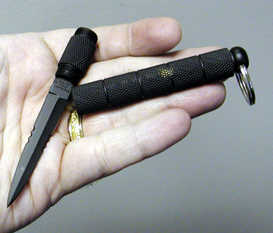
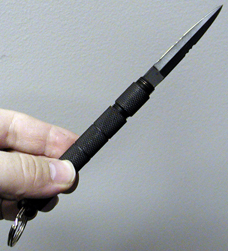
The “Ninja Keyrings” available that have metal protrusions that thrust out between the fingers are similarly poor ideas. For one thing, it’s difficult to see these devices as keychains — they practically scream “offensive weapon.” For another thing, they’re bulky, awkward, and difficult to carry comfortably. Don’t waste your money on these.
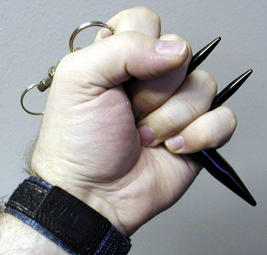
STRIKING AND TARGETING WITH THE POCKET STICK
Now that we’ve covered the basics, let’s talk about striking, and the targets to strike on a human being. We won’t be covering joint locks and other compliance techniques that use the pocket stick for leverage, however. Generally speaking, these are sometimes too complicated for pragmatic street defense and too involved for the average person’s use. We also won’t cover using the pocket stick as the handle of a key flail. Flails, even when performed with a gigantic wad of keys on the end of the stick, simply aren’t effective. A flail to the eyes has some value, but this is nothing you can’t accomplish with a wrist flick or bil jee (finger jab) to the same target.
For the sake of simplicity we will focus on two striking methods: forward thrusts and reverse hammer strikes. The forward strike is one in which the pocket stick is held like a saber and used with a forward thrust straight into the target. This is a good linear technique, though the saber grip is not the strongest for a pocket stick.
When gripping the pocket stick like a fist load, it will project from one or both sides of your hand. The most powerful blow you can deliver using this grip is a downward hammerfist strike. (You can also deliver upward blows if sufficient stick length projects from the top of the fist, but I favor the reverse strikes because they are stronger). Those same downward hammerfist strikes can be delivered laterally as backhands.
The nature of the pocket stick as a daily companion implies that you’ll draw and use it from virtually any posture. I won’t recommend specific modes of carry or draw. I think these are very individualized and therefore up to you to discover and practice through experimentation. This isn’t rocket science, after all. It’s a tiny stick that you carry until you grab it and poke someone with it.
If given the luxury of preparing for an assault, you may choose to adopt a specific ready posture. I’ve used variations on the following stances to deter aggressive street people. These are nothing more than interpretations of the double wu sao guard of Wing Chun or the staggered “fence” or “de-escalation” Reality Based Self Defense stances. In one, the stick is in a forward grip for thrusts, while in the other it is readied for backhand hammer blows. The weapon is forward, where it should be, between you and the assailant.


Forward thrust and backhand hammerfist ready postures.
The forward thrust would normally be oriented more
towards the assailant’s eyes than vertically as shown here.
It goes without saying that you’ll only use a weapon to hit someone if you are justified in using multiplied force in defense of yourself or someone else. I can’t address specific scenarios here, so we’ll stipulate that you have a need to and are justified in planting the end of your stick in another person. This will be done to damage or deter the attacker. The mechanics of striking someone while protecting your own vital areas are outside the scope of this article, but you’re not going to learn the totality of self-defense reading a single online description. What we can cover are the vulnerable points you should or could target in defending yourself.
WARNING! The techniques described are potentially lethal and could, at the very least, cause severe or permanent injury. The following is presented for information purposes only. The Martialist and its staff cannot be held responsible for the misuse of this information. The guidelines given do not constitute legal advice.
Tak Kubota, who popularized the kubotan keychain, offers the following diagram of striking points in his manual for the device:
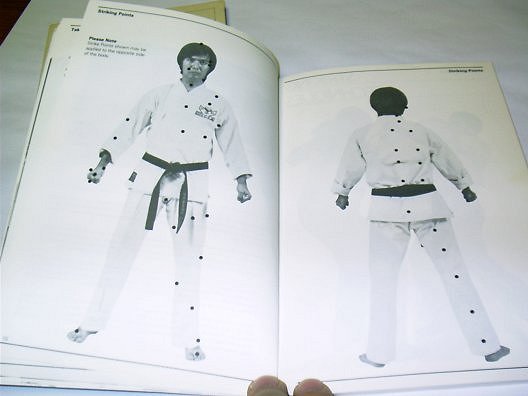
We’re going to keep things a little simpler than that. The head and neck are the most vulnerable to pocket stick strikes. Using either the saber or hammer grip, you can drive the pocket stick into the general zone of the eyes, into the cheeks) less vulnerable to quite painful), under the chin (and anywhere in the neck area), and into the hollow of the throat. You can also jam the stick into an ear or into the temple, with varying results. Do what you must.


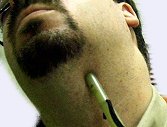
Eye, cheek, and neck targets. Don’t be afraid to put the stick
straight through spectacles.
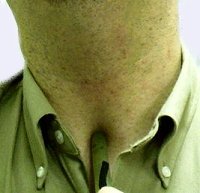
The hollow of the throat, which is
very vulnerable (but a small target).
Strikes elsewhere on the body create varying degrees of pain and debilitation. I cannot guarantee that any given strike will “stop” an attacker, but there are a number of body options. Blows to the side of the lower torso or to the armpit cause pain, as do strikes to the pectorals, to the biceps, inside the elbows, and to the gut. Kidney shots are unpleasant, too, as are strikes to the thighs, shins, and calves. Obviously, a shot to the groin will generate some notice.
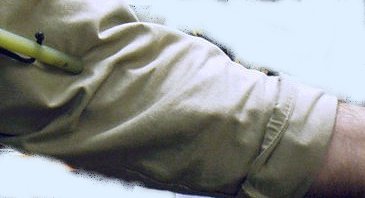
Striking area inside the elbow.
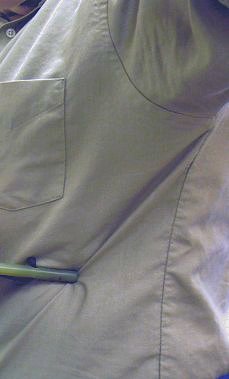
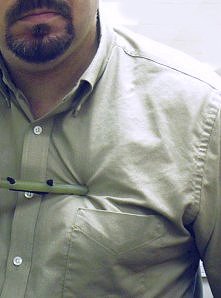
The sides of the body under the arms and the pectorals are also targets.
When striking a grasping or grabbing limb – say, the hand or arm of someone poking you, grabbing your shirt, or reaching into your car – the backs of the hands are quite vulnerable, as are the areas of the arm inside the wrist and forearm. One technique used against a “bear hug” is to grind the knuckles of your hand into the back of the attacker’s exposed hand. This is very painful with just knuckles but becomes even more so when grinding with a pocket stick.
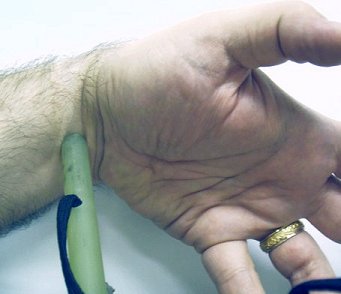
Inside the wrist is one good target area.
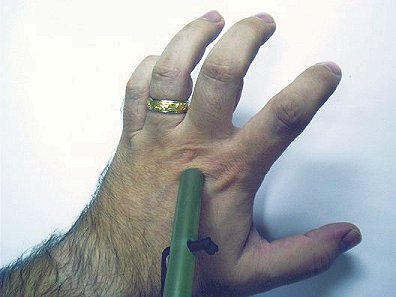
The back of the hand is vulnerable.
The techniques shown with sticks here will obviously work with any small, similarly shaped object. These include small flashlights as well as pens and pencils. Any item that is sharp like a pencil will penetrate flesh if used with sufficient force, so keep that in mind. A simple pressure strike with a kubotan can become a stab with the tip of a ball-point pen.
A pocket stick is a remarkably powerful tool in a very small envelope. It is potentially lethal and must be considered a deadly weapon, even if it is not used to deliver fatal techniques. The average citizen with a little training and a pocket stick is well equipped for many self-defense scenarios.
The pocket stick is not a magic wand, but it does a lot for such a simple tool.
CONCLUSION
There is no excuse for not carrying a pocket stick, provided there are no laws where you live forbidding them. A powerful, portable, simple device that greatly amplifies your ability to deliver force when necessary, the pocket stick is an overlooked and underestimated self-defense tool. While the material, shape, length, and design of your pocket stick is a matter of personal preference, the basic concept behind the device is one that has been applied successfully for centuries.
Do not ignore it.
Great article. I’m a big fan of the pocket stick, and recently have started a little collection. I also really enjoyed the piece on construction on as well. After some research I have found that tactical pens and markers, suit my own personal needs as I’m waiter and well the pen makes sense. the down is though they aren’t cheap and I’d like to have more than one. A broom handle is just as effective for a cost effective solution. I just wanted to say “good stuff guys keep it up!”
Yuri
I enjoyed the article on the pocket stick. I remember how it was impressed on us while practicing dagger strikes from Fiores Flos Duelletorum that the strikes (which are often delivered in an icepick grip and aimed at the neck and groin) are extremely dangerous with a wooden dowel, a compact umbrella, a flashlight or even a roll of coins.
When you said a sabre grip, is that traditional sabre, with your thumb along the spine of the handle?
When I am in the UK where carrying anything for self defence is frowned upon; I always have a 6″ rawhide dog chew in my back pocket. Extremely hard, and effective as a yarawa, if I were to be asked why I have it, obviously as a treat for my friend’s dog.
To make a really tough one just get a normal dog chew and soak it to unravel it then put it back together but twisted as tight as possible, then leave it with the ends nailed down until it is really dry.You can sand the ends to whatever shape you like.
Yes,…neat idea with the rawhide “stick” 🙂
The UK has been off the list of Countries I can sell my Ti Rod Tactical Titanium Pocket sticks into for just the reason you describe. They would be seized. That may change over time, especially since the several UK Terrorist attacks recently. When are those in Governmental positions going to realize THEY can’t protect YOU when you are physically attacked! This especially so in a Country where the majority of their Police force is “unarmed”, ….save for a baton. 🙁
I am especially saddened by their stance on Pocket Sticks, for I am forever tied to Great Britain in a way most Americans are not. My dad was in the US Army in 1955, and was stationed in the UK doing aerial mapping for awhile. A different time for sure, as after about 6 months of separation my mom went over to visit, and they both were welcomed into a stranger’s countryside home where they lived for an extended time. (over 1-1/2 years)
They were obviously REALLY happy to see each other again too, because I was born just 9 months later! (Perfect timing if you ask me, …way to go DAD! 🙂
….you might even say I was Born,….. and “Made” in the UK! hehe
We all flew back to the US when I was was 6 months old,…..and it must have been a hell of a flight (in a Military transport I think?), because I have NEVER flown since! (that probably won’t change either, since I’m almost 61 now 🙂
Stay Safe!
Joseph Tousignant
Ti Rod Tactical
I love all the fake tough guys. “I ain’t afraid of no Covid-19”, but the same doofus needs a machine gun or three to “protect” his home. Bunch of delusional incels!
Personally ,living in the UK ,I would Carry the small cylindrical fit in the fist torch as a sort of reverse knuckle duster.
Getting stopped by the police they can’t complain about a pocket torch.